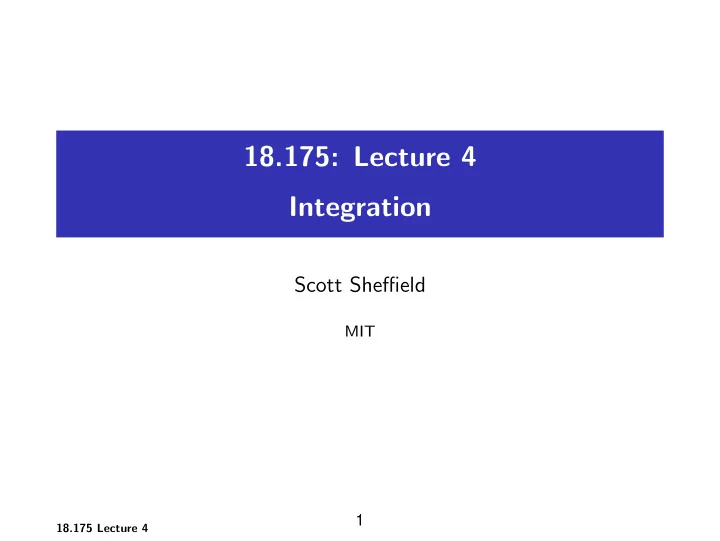

18.175: Lecture 4 Integration Scott Sheffield MIT 1 18.175 Lecture 4
Outline Integration Expectation 2 18.175 Lecture 4
Outline Integration Expectation 3 18.175 Lecture 4
Recall definitions � Probability space is triple (Ω , F , P ) where Ω is sample space, F is set of events (the σ -algebra) and P : F → [0 , 1] is the probability function. � σ -algebra is collection of subsets closed under complementation and countable unions. Call (Ω , F ) a measure space. � Measure is function µ : F → R satisfying µ ( A ) ≥ µ ( ∅ ) = 0 for all A ∈ F and countable additivity: µ ( ∪ i A i ) = J i µ ( A i ) for disjoint A i . � Measure µ is probability measure if µ (Ω) = 1. � The Borel σ -algebra B on a topological space is the smallest σ -algebra containing all open sets. 4 18.175 Lecture 4
Recall definitions Real random variable is function X : Ω → R such that the � � preimage of every Borel set is in F . Note: to prove X is measurable, it is enough to show that the � � pre-image of every open set is in F . Can talk about σ -algebra generated by random variable(s): � � smallest σ -algebra that makes a random variable (or a collection of random variables) measurable. 5 18.175 Lecture 4
Lebesgue integration Lebesgue: If you can measure, you can integrate. � � In more words: if (Ω , F ) is a measure space with a measure µ � � with µ (Ω) < ∞ ) and f : Ω → R is F -measurable, then we can define < fd µ (for non-negative f , also if both f ∨ 0 and − f ∧ 0 and have finite integrals...) Idea: define integral, verify linearity and positivity (a.e. � � non-negative functions have non-negative integrals) in 4 cases: � f takes only finitely many values. � f is bounded (hint: reduce to previous case by rounding down or up to nearest multiple of E for E → 0). � f is non-negative (hint: reduce to previous case by taking f ∧ N for N → ∞ ). � f is any measurable function (hint: treat positive/negative parts separately, difference makes sense if both integrals finite). 6 18.175 Lecture 4
Lebesgue integration Can we extend previous discussion to case µ (Ω) = ∞ ? � � Theorem: if f and g are integrable then: � � If f ≥ 0 a.s. then < fd µ ≥ 0. � For a , b ∈ R , have ( af + bg ) d µ = a fd µ + b gd µ . < < < � If g ≤ f a.s. then < gd µ ≤ < fd µ . < < � If g = f a.e. then gd µ = fd µ . � < < | fd µ | ≤ | f | d µ . � When (Ω , F , µ ) = ( R d , R d , λ ), write < < f ( x ) dx = 1 E fd λ . � � E 7 18.175 Lecture 4
Outline Integration Expectation 8 18.175 Lecture 4
Outline Integration Expectation 9 18.175 Lecture 4
MIT OpenCourseWare http://ocw.mit.edu 18.175 Theory of Probability Spring 2014 For information about citing these materials or our Terms of Use, visit: http://ocw.mit.edu/terms.
MIT OpenCourseWare http://ocw.mit.edu 18.175 Theory of Probability Spring 2014 For information about citing these materials or our Terms of Use, visit: http://ocw.mit.edu/terms.
Recommend
More recommend